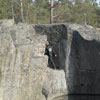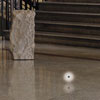Reaching, 2018-2019
Public event: composed with buildings, climbers, safety devices, trumpet player, printed matters, text, images, clothes, hand honed spectrolite in hand made wooden case
Commission work for Sculpture Expanded in collaboration with The Association of Finnish Sculptors, Paasitorni, and The National Museum of Finland
------
Printed matters:
8 pages prints / page size in 350mm x 500mm
Concept and design by Shoji Kato
Text by Mika Savela
Clothing designed by
Shoji Kato and John Phillip Mäkinen
and Tailored by Ossi Rantanen and John Phillip Mäkinen
Wooden case for the Spectrolite
by UUP Yoshimasa Yamada
The National Museum of Finland on May 17, 2019
Climbing Crew:
Roosa Huhtikorp
Kalle Karjalainen
Elisa Kopra
Jukka Kopra
Jere Kovamäki
Leo Leipakka
Trumpet improvisation by Onni Pietilä based on Finish National Anthem, Maamme, and Savolaisten laulu (sung at the masonry ceremony of the National Museum of Finland in 1906)
Paasitorni on August 15, 2019
Climbing Crew:
Kalle Karikoski
Elisa Kopra
Jukka Kopra
Jere Kovamäki
Aino Kuokka
Leo Leipakka
Trumpet improvisation by Onni Pietilä based on Savolaisten laulu (sung at the inauguration ceremony of the Helsinki Workers' House [now Paasitorni] in 1908)
world stone
Mika Savela
One doesn’t really often think or talk about stone , even though we could say the world is made of it. It is perhaps even somewhat comical that something so perpetual-seeming in the temporal context of human life, is not really ”set in stone”. The permanence and the deadly, crushing weight of stone is countered by cultural storylines and a kind of fascination towards its ontology and celebratory symbolism.
There is, for instance, an aesthetics of stone. These understandings and meanings are fickle and changing over time. Marble is Versace, Borromini and Praxiteles. Granite, is the easy-to-clean kitchen, the default choice in the funeral home catalog and the basic platform of a 1980s Finnish corporate gift cheese set.
The permanence of stone make it precious. In classical architecture the built world is made of stone and its imitations. But at large, ornaments on the facades and the most delicate and precious objects are almost never made of granite. Granite is the heavy base or the earthy block. More laborious than luxurious. Granite is mass, not preciousness.
Yet, there are many monuments made of this particular stone. There are cultural and material worlds around it. Particularly in the Nordic context, granite is plentiful and omnipresent while the material world is naturally limited. Stone, wood, water, air, snow or dirt as particles of culture are often solemn and plain.
Thus, for a long time, one could say the Finnish understanding of stone was not ornamental or frivolous, flirty or coquettish, stately or stylish. The perceived qualities of stone as material were visually curated by the limitation of means. Stones laid as foundations or as walls or used to grind rye and wheat were possibly beautiful, but not because they were in vogue.
Finnish granite stone is hard, mostly dark or lighter gray, occasionally reddish or brown, and solidified almost two billion years ago. That is perhaps why, it is interesting to consider the very idea of granite or its displays as examples of something archaic crashing with cultural notions belonging to other worlds created outside of nature and necessity.
Perceiving granite as a commercial material, or monumental stone was possible due to its commodification. Sometime in the 17th century people started to truly extract granite and other rocks in the Finnish countryside, to be utilized for example as the main building blocks of military fortresses. One may imagine how utterly different ideas the people sourcing the stones for an architectural purpose held in comparison with the people living among them.
In the 19th century many historical notes emerge from these clashes between worlds made around stones. Massive construction projects in Russia demanded import of materials but also worlds made of ideas of what stone could portray, how it could be displayed and what purpose could it serve in monumentalization. Stones came from Finland, academic skills and fashion from continental Europe.
In 1830 some two hundred men started to extract a 30 meter-long block of red granite in a quarry in Pyterlahti, Eastern Finland. Just imagine how it must have been, a French architect named Auguste de Montferrand walking around the site, surveying the rocks, and finding a vast continuous granite deposit, seeing its potential as a symbolic structure.
Two years later, over 3,000 people participated in its erection as a monumental column in St. Petersburg, using a specifically engineered system of ropes and pulleys to maneuver the 600 ton block in its place. Over the years thousands of workers lived in a village by the same quarry and several European royalties visited the site. Vast stones were extracted and sent far away, to be used as church columns, flooring, steps and pedestals. Again, these pools of technical knowledge, and purposes and origin stories of stone would existed almost like they were in parallel universes.
But then, in this other world of stone and worldly culture, too, granite could be seen as an import of mythical proportions. In front of architect Karl Friedrich Schinkel’s Altes Museum in Berlin, a vast granite bowl serves as a focal point of the Lustgarten park. Originally the bowl was cut out from a notably large Glacial erratic in Brandenburg, having found its way there thousands of years ago from Scandinavia during the Ice Age. After the cut, the resulting mass was carved into a bowl and polished. Its transport to Berlin required the building of routes through forests, some that still exist today.
The granite bowl in Lustgarten appears in Johann Erdmann Hummel’s 1831 painting. The image features an odd view of the bowl during its installation, exemplifying its size and lustre, making sure that the viewer understands its seamlessness, its massive and mind boggling heaviness, its primitivity brought into the world of reason. In fact, these kind of examples must have felt like triumphs, wonders of the world. But more than that, they exemplify again and again, the magnitude of the temporal, cultural and material networks created by stone. Stones permeating the world. Stones simply existing in time.
What, then, are worlds? According to French philosopher Jean-Luc Nancy, we don’t actually have the luxury of such coherent things that we can call worlds anymore. German artist and filmmaker Hito Steyerl has similarly talked about the issue of having “too much world” in reference to our current post-internet era. Yet, it seems difficult to think that the stones that have been here long before us and will continue to be here when we are gone, would not at least in some ways be particles of a world and time entirely of their own.
It might be casual, then, to say that stone is time solidified into history. But perhaps the existence of a stone or a world is both beyond our reach and very concrete at the same time. The physical world, too, at least in a planetary scale could be called a rock. And it seems we are very much stuck on living in the materiality of stone, and the many interpretations we have placed on its existence in our worlds over time.
There is something similar in many of the stories related to understanding and utilizing stone. Perhaps this is obvious even in the earliest ways to talk about stones. In post-glacial Northern Europe, when the various people started to roam the forests and lakesides, they would take notice of the massive stones and rocks landed there, seemingly out of nowhere. Perhaps thrown there by giants, perhaps inhabited by spirits. And yet, while being otherworldly due to our inabilities in understanding the origins of the world, stone has been at the same time the most banal and utilitarian part of our material practices. A part of world.
For the Sculpture Expanded, I wanted to make a sculptural work that has no outline and that is evolving.
I also imagined to create a situation, or maybe to present a new set of social relations with something that has been forgotten, taken for granted and something that isn’t so visible.
So I have composed some researched and interpreted materials together, and here soon, there would be the engagement between the symbolic buildings made with Finnish granite and the human spirits of contemporary climbing bodies.
The title of this work, Reaching, suggests a number of different movements of organic and inorganic bodies. They both are moving towards dreams, goals, agreements, targets, or something unattainable perfectly.
The human actors in this work are not at all posing for the sake of art, but they are seriously challenging.
Their skill, sweat and spirit are very special, but at the same time, they become metaphorical in this work.
I think that they make us imagine the continuity in different times and the similar movements in different places.
I also wanted to create a chance to look into the stones through the history of planet, territory, city and culture, that have much affiliations with the ideas around location and landscape.
It will be thrilling to see the work of climbers on the vertical space, and I think it is also a great moment to listen to the stones – imagining what they would say about the careful, and even creative positioning of the fingers and toes.
------
Acknowledgements :
Mari Jalava
Aki Välimäki
Mika Savela
Heikki Mäenpää
Hiroaki Hodai
The Association of Finnish Sculptors:
Tiina Veräjänkorva
Maria Junno
Moona Tikka
Marika Heiskanen
Paasitorni:
Osku Pajamäki
Kati Kosonen
The National Museum of Finland:
Hanna Forssell
Tomi Nikander
Viktor Sohlström
|


